Feasibility Study of Grinding Circulating Fluidized Bed Ash as Cement Admixture
Abstract
:1. Introduction
2. Materials and Methods
2.1. Materials
2.2. Methods
3. Results and Discussion
3.1. Physicochemical Analysis of CFBA
3.1.1. Chemical Composition of CFBA
3.1.2. Physicochemical Characteristics of CFBA
3.2. Influence of Grinding Time on the Properties of CFBA
3.2.1. Influence of Grinding Time on CFBBA
3.2.2. Effect of Grinding Time on the Water-Demand Ratio of CFBA
- (a)
- As shown in Figure 8, with the decrease in the particle size, some of the particles played a micro-filling role, and the fine particles filled in the gaps in the coarse particles, reducing the porosity and the use of water [36]. Furthermore, with the addition of CFBA to the cement, the particle size distribution of the CFBA cement system changed, which affected the bulk density of the slurry by reducing the amount of retained water [37,38]. In addition, the grinding effect made the particles of CFBA more and more spherical, and the fine spherical particles also played a role in the lubrication of the balls. Therefore, less water was needed for the mortar to flow better, thereby reducing the water-demand ratio of CFBA.
- (b)
- As shown in Figure 9, when all particles were reduced, pores were generated between the particles and the porosity increased, which worsened the fluidity of the mortar [39]. Therefore, more water was needed for the mortar to achieve a better flow, resulting in an increase in the water-demand ratio of CFBA. This explains the mechanism by which the water-demand ratio increased when the grinding time further increased.
- (c)
- The effect of the carbon content of CFBA on the water-demand ratio was also tested. Wu Bin et al. showed that the water-demand ratio of pulverized coal ash increased with the increase in the carbon content [40]. Similarly, the greater the burn losses of CFBA, the greater the carbon content. The particles with high carbon content were coarse, porous, non-gelling, and easily absorb water, which increased the water-demand ratio of CFBA.
3.2.3. Effect of Grinding Time on Compressive Strength and Flexural Strength of CFBA Mortar
4. Conclusions
- Grinding can effectively reduce the particle size of CFBA and ensure it meets the standard requirements. However, with the increase in grinding time, the particles are attracted by electrostatic force and van der Waals force, and the particle size of CFBA caused by agglomeration increases.
- Grinding can reduce the water-demand ratio of CFBA. Because the fineness of CFBFA is still relatively coarse and the carbon content of CFBFA is higher, grinding only CFBBA cannot ensure that CFBA meets the water-demand ratio requirement. When the grinding time of CFBBA is 10 min and the grinding time of CFBFA is 4 min, the water-demand ratio of CFB meets the requirements.
- Grinding can improve the compressive and flexural strengths of the mortar when CFBA is used as a cement admixture. Under the condition that the grinding time of CFBFA is 4 min, when the grinding time of CFBBA is 10 min rather than 2 min, the compressive strength of the 28-day-old mortar test block of CFBA increases by 7.05% and the flexural strength changes slightly. The strength activity coefficient of CFBA at 28 d meets the requirements of cement admixtures.
- CFBA can be used as a cement admixture to meet the requirements of the GB/T 1596-2017 standard by grinding. The optimal grinding time of CFBBA is 10 min and the optimal grinding time of CFBFA is 4 min.
Author Contributions
Funding
Institutional Review Board Statement
Informed Consent Statement
Data Availability Statement
Conflicts of Interest
References
- Anthony, E.J.; Granatstein, D.L. Sulfation phenomena in fluidized bed combustion systems. Progr. Energy. Combust. Sci. 2001, 27, 215–236. [Google Scholar] [CrossRef]
- Koornneef, J.; Junginger, M.; Faaij, A. Development of fluidized bed combustion—An overview of trends, performance and cost. Progr. Energy. Combust. Sci. 2007, 33, 19–25. [Google Scholar] [CrossRef]
- Sheng, G.; Zhai, J.; Li, Q.; Li, F. Utilization of fly ash coming from a CFBC boiler cofiring coal and petroleum coke in Portland cement. Fuel 2007, 86, 2625–2631. [Google Scholar] [CrossRef]
- Liu, F.; Gu, G.; Han, Z. Type of Boilers and Characteristic of Crystalline Phases of Fly Ash. J. Tongji Univ. 2003, 31, 990–994. [Google Scholar]
- John, S.K.; Nadir, Y.; Girija, K. Effect of source materials, additives on the mechanical properties and durability of fly ash and fly ash-slag geopolymer mortar: A review. Constr. Build. Mater. 2021, 28, 122443. [Google Scholar] [CrossRef]
- Shen, Y.; Qian, J.; Zhang, Z. Investigations of anhydrite in CFBC fly ash as cement retarders. Constr. Build. Mater. 2013, 40, 672–678. [Google Scholar] [CrossRef]
- Nowoswiat, A.; Golaszewski, J. Influence of the Variability of Calcareous Fly Ash Properties on Rheological Properties of Fresh Mortar with Its Addition. Materials 2019, 12, 1942. [Google Scholar] [CrossRef]
- Wan, S.; Zhou, X.; Zhou, M.; Han, Y.; Chen, Y.; Geng, J.; Wang, T.; Xu, S.; Qiu, Z.; Hou, H. Hydration characteristics and modeling of ternary system of municipal solid wastes incineration fly ash-blast furnace slag-cement. Constr. Build. Mater. 2018, 180, 154–166. [Google Scholar] [CrossRef]
- Kalaw, M.E.; Culaba, A.; Hinode, H.; Kurniawan, W.; Gallardo, S.; Promentilla, M.A. Optimizing and Characterizing Geopolymers from Ternary Blend of Philippine Coal Fly Ash, Coal Bottom Ash and Rice Hull Ash. Materials 2016, 9, 580. [Google Scholar] [CrossRef]
- Lin, W.T.; Lin, K.L.; Chen, K.; Korniejenko, K.; Hebda, M.; Lach, M. Circulation Fluidized Bed Combustion Fly Ash as Partial Replacement of Fine Aggregates in Roller Compacted Concrete. Materials 2020, 12, 4204. [Google Scholar] [CrossRef]
- Cui, Y.F.; Gao, K.K.; Zhang, P. Experimental and Statistical Study on Mechanical Characteristics of Geopolymer Concrete. Materials 2020, 13, 1651. [Google Scholar] [CrossRef] [PubMed]
- Li, J.; Ma, Z.; Gao, J.; Guo, Y.; Cheng, F. Synthesis and characterization of geopolymer prepared from circulating fluidized bed-derived fly ash. Ceram. Int. 2022, 48, 11820–11829. [Google Scholar] [CrossRef]
- Wu, T.; Chi, M.; Huang, R. Characteristics of CFBC fly ash and properties of cement-based composites with CFBC fly ash and coal-fired fly ash. Constr. Build. Mater. 2014, 66, 172–180. [Google Scholar] [CrossRef]
- Li, X.; Chen, Q.; Huang, K.; Ma, B.; Wu, B. Cementitious properties and hydration mechanism of circulating fluidized bed combustion (CFBC) desulfurization ashes. Constr. Build. Mater. 2012, 36, 182–187. [Google Scholar] [CrossRef]
- Sheng, G.H.; Li, Q.; Zhai, J.P.; Li, F.H. Self-cementitious properties of fly ashes from CFBC boilers co-firing coal and high-sulphur petroleum coke. Cem. Concr. Res. 2007, 37, 871–876. [Google Scholar] [CrossRef]
- Song, Y.M.; Qian, J.S.; Wang, Z.; Wang, Z.J. Self-cementing mechanism of CFBC coal ashes at early ages. J. Wuhan Univ. Technol. Mater. Sci. Ed. 2008, 23, 338–341. [Google Scholar] [CrossRef]
- Shon, C.S.; Mukhopadhyay, A.K.; Saylak, D.; Zollinger, D.D.G.; Mejeoumov, G.G. Potential use of stockpiled circulating fluidized bed combustion ashes in controlled low strength material (CLSM) mixture. Constr. Build. Mater. 2010, 24, 839–847. [Google Scholar] [CrossRef]
- Hwang, S.; Yeon, J.H. Fly Ash-Added, Seawater-Mixed Pervious Concrete: Compressive Strength, Permeability, and Phosphorus Removal. Materials 2022, 15, 1407. [Google Scholar] [CrossRef]
- Shoppert, A.; Loginova, I.; Valeev, D. Kinetics Study of Al Extraction from Desilicated Coal Fly Ash by NaOH at Atmospheric Pressure. Materials 2022, 14, 7700. [Google Scholar] [CrossRef]
- Ma, Z.; Zhang, X.; Guo, Y.; Cheng, F. Research progress on characteristics and element dissolution behaviors of circulating gluidized bed-derived fly ash. Chem. Ind. Eng. Prog. 2021, 40, 3058–3071. [Google Scholar]
- Davidovits, J. 30 Years of Successes and Failures in Geopolymer Applications. Market Trends and Potential Breakthroughs. In Proceedings of the Geopolymer 2002 Conference, Melbourne, Australia, 28–29 October 2002. [Google Scholar]
- National Bureau of Statistics Home Page. Available online: http://www.stats.gov.cn/ (accessed on 6 June 2022).
- Rajaram, S. Next generation CFBC. Chem. Eng. Sci. 1999, 54, 5565–5571. [Google Scholar] [CrossRef]
- Burak, F.; Selçuk, T.; Hasan, K. Optimization of fineness to maximize the strength activity of high-calcium ground fly ash—Portland cement composites. Constr. Build. Mater. 2009, 23, 2053–2061. [Google Scholar]
- Havlica, J.; Brandstetr, J.; Odler, I. Possibilities of utilizing solid residues from pressured fluidized bed coal combustion (PSBC) for the production of blended cements. Cem. Concr. Res. 1998, 28, 299–307. [Google Scholar] [CrossRef]
- Lu, X.F.; Amano, R.S. Feasible experimental study on the utilization of a 300 MW CFB boiler desulfurizating bottom ash for construction applications. J. Energy Resour. Technol. 2006, 128, 311–318. [Google Scholar] [CrossRef]
- Zhang, W.; Liu, X.; Zhang, Z.; Wang, Y.; Xue, Y.; Hao, X.; Lu, Y. Circulating Fluidized Bed Fly Ash Mixed Functional Cementitious Materials: Shrinkage Compensation of f-CaO, Autoclaved Hydration Characteristics and Environmental Performance. Materials 2021, 14, 6004. [Google Scholar] [CrossRef]
- Sheng, G.; Li, Q.; Zhai, J. Investigation on the hydration of CFBC fly ash. Fuel 2012, 98, 61–66. [Google Scholar] [CrossRef]
- Li, X.; Chen, Q.; Ma, B.; Huang, J.; Jian, S.; Wu, B. Utilization of modified CFBC desulfurization ash as an admixture in blended cements: Physico-mechanical and hydration characteristics. Fule 2012, 102, 674–680. [Google Scholar] [CrossRef]
- Tkaczewska, E. Effect of the superplasticizer type on the properties of the fly ash blended cement. Constr. Build. Mater. 2014, 70, 388–393. [Google Scholar] [CrossRef]
- Zheng, D.; Wang, D.; Li, D.; Ren, C.; Tang, W. Study of high volume circulating fluidized bed fly ash on rheological properties of the resulting cement paste. Constr. Build. Mater. 2017, 135, 86–93. [Google Scholar] [CrossRef]
- Sun, H.; Qian, J.; Peng, S.; Xiong, M.; Fan, C.; Fan, Y. Utilization of circulating fluidized bed combustion ash to prepare supersulfated cement. Constr. Build. Mater. 2022, 318, 125861. [Google Scholar] [CrossRef]
- Giergiczny, Z. The hydraulic activity of high calcium fly ash. J. Therm. Anal. Calorim. 2006, 83, 227–232. [Google Scholar] [CrossRef]
- Song, Y.; Qian, J.; Wang, Z. Pozzolanic activity of coal ash. J. Chin. Ceram. Soc. 2006, 34, 962–965. [Google Scholar]
- Gołaszewski, J.; Giergiczny, Z.; Ponikiewski, T.; Kostrzanowska-Siedlarz, A.; Miera, P. Effect of calcareous fly-ash processing methods on rheological properties of mortars. Period. Poly. Civil Eng. 2018, 62, 643–652. [Google Scholar] [CrossRef]
- Li, Q.; Liao, C.; Hou, J.; Zhang, J. Research progress on coal water slurry particle size gradation model and practice. Clean Coal Technol. 2021, 27, 41–49. [Google Scholar]
- Lee, S.H.; Kim, H.J.; Sakai, E.; Daimon, M. Effect of particle size distribution of fly ash-cement system on the fluidity of cement pastes. Cem. Concr. Res. 2003, 33, 763–768. [Google Scholar] [CrossRef]
- Grzeszczyk, S.; Lipowski, G. Effect of content and particle size distribution of high-calcium fly ash on the rheological properties of cement pastes. Cem. Concr. Res. 1997, 27, 907–916. [Google Scholar] [CrossRef]
- Zhao, J.; Wang, D.; Hui, F.; Wang, X.; Liao, S.; Lin, H. Research and performance improvement of circulating fluidized bed ash as cement mixture. Sci. Technol. Engrg. 2014, 18, 129–134. [Google Scholar]
- Wu, B.; Luo, X.; Zhao, J. Effect of fly ash quality on its water demand and activity. Sichuan Build. Mater. 2015, 41, 23–24. [Google Scholar]
- Zhao, J.; Wang, D.; Liao, S. Effect of mechanical grinding on physical and chemical characteristics of circulating fluidized bed fly ash from coal gangue power plant. Constr. Build. Mater. 2015, 101, 851–860. [Google Scholar] [CrossRef]


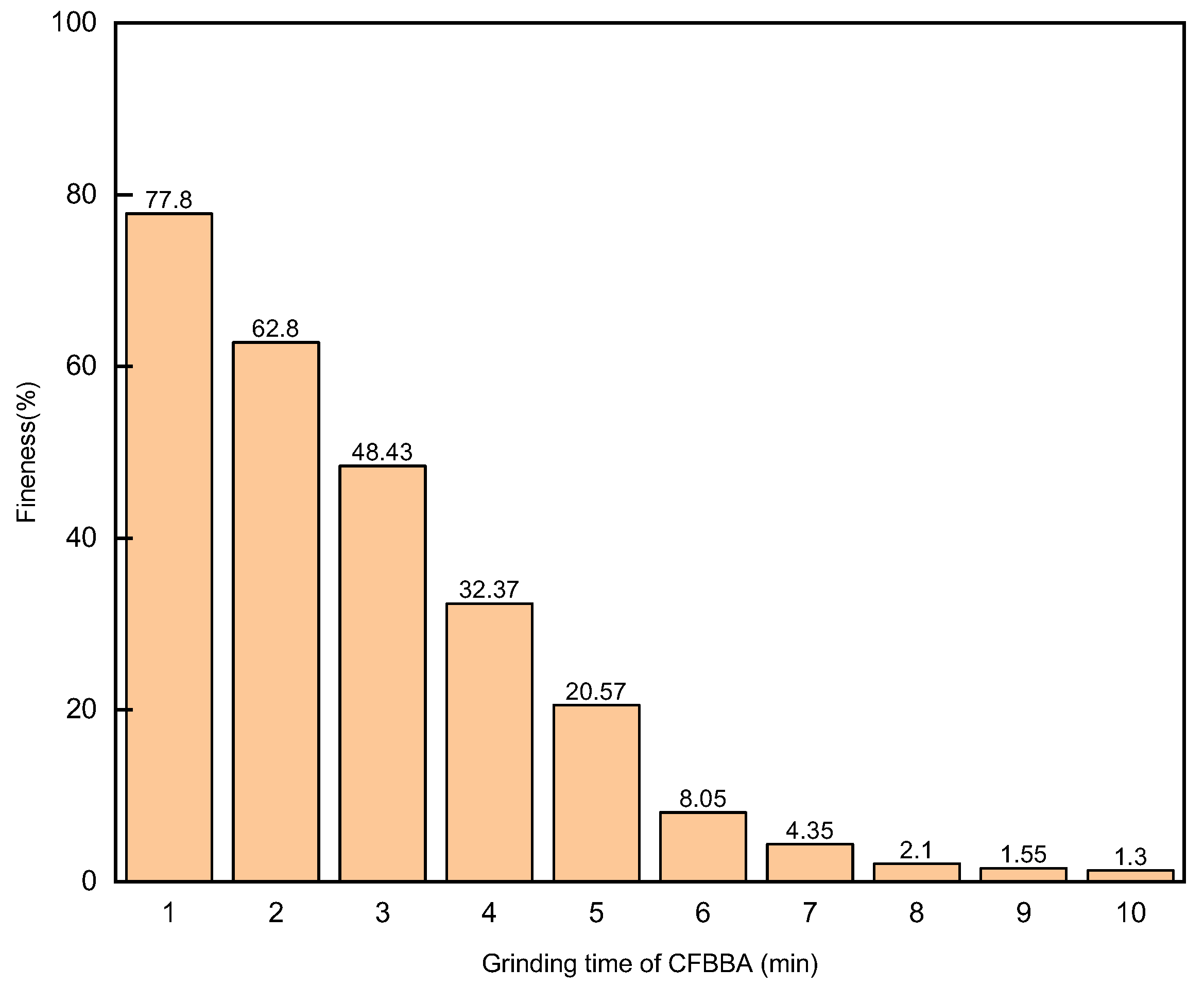
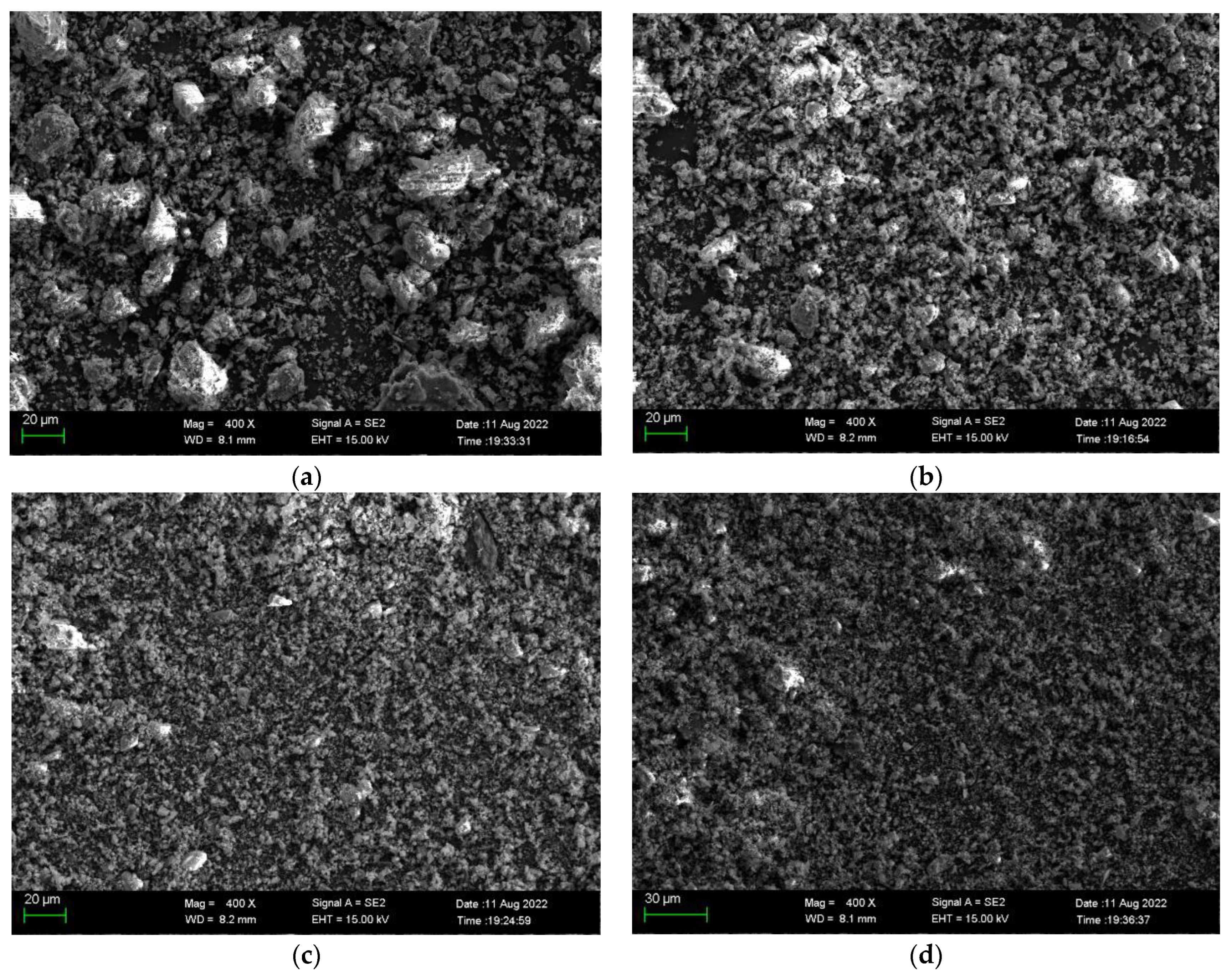
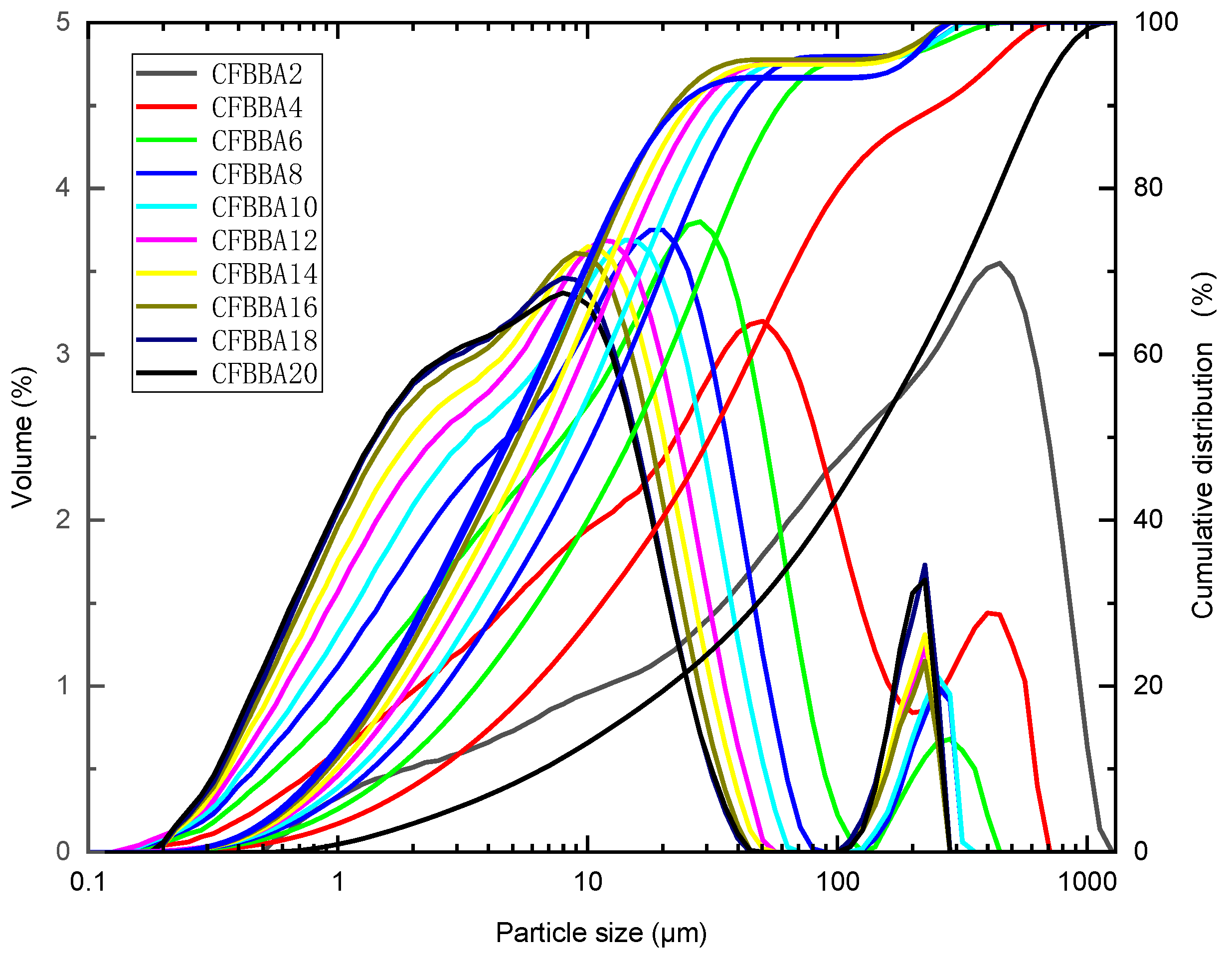
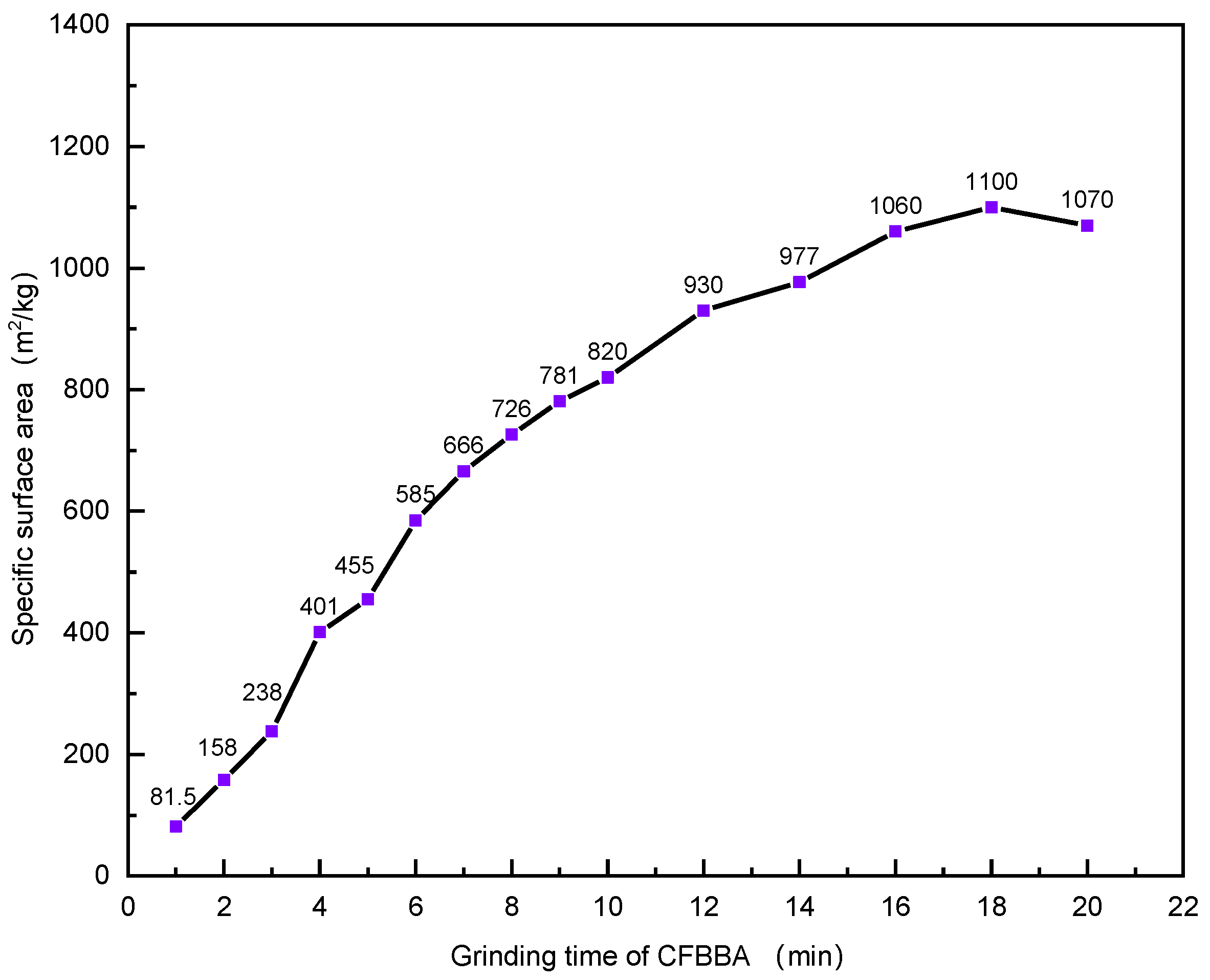
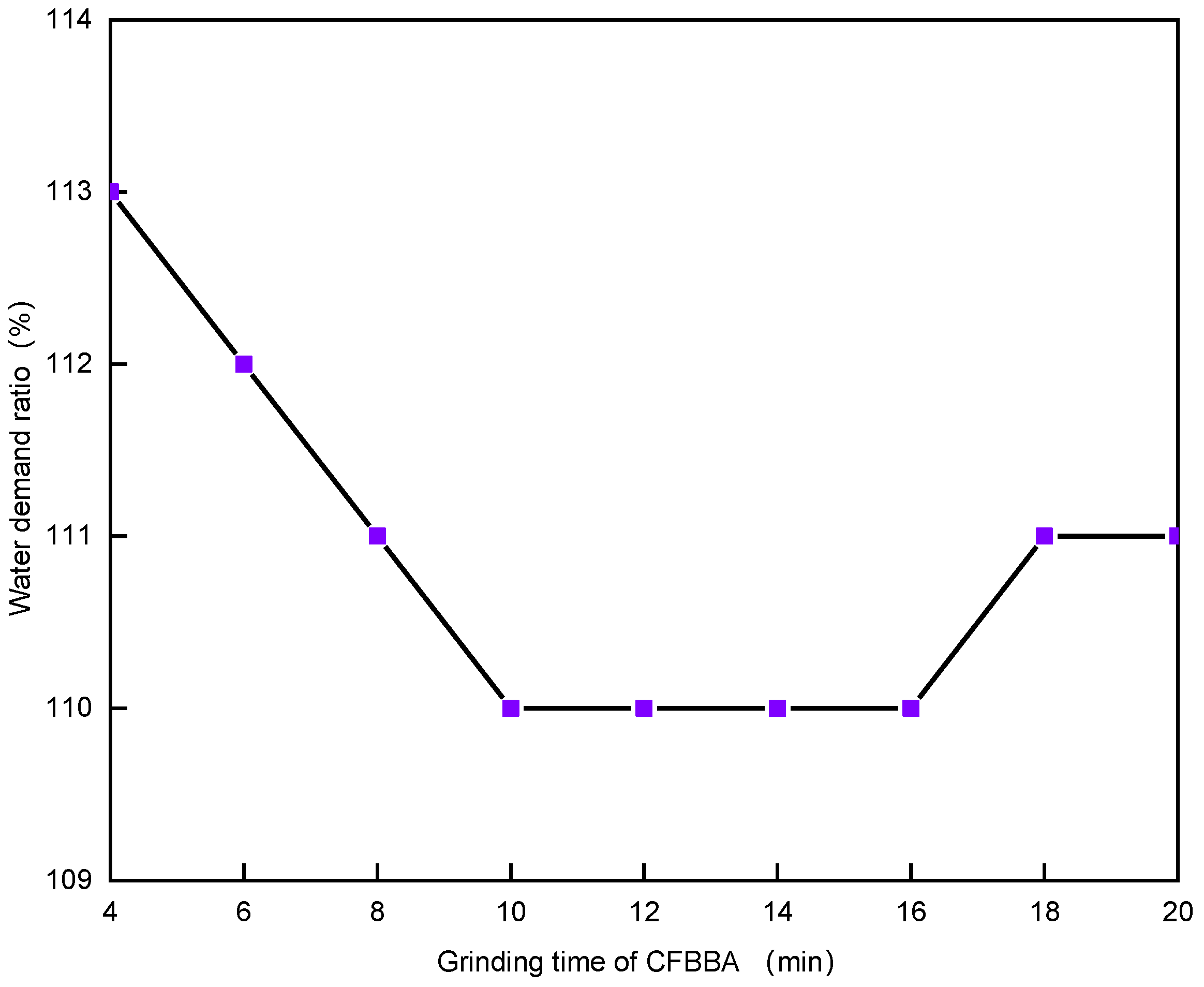
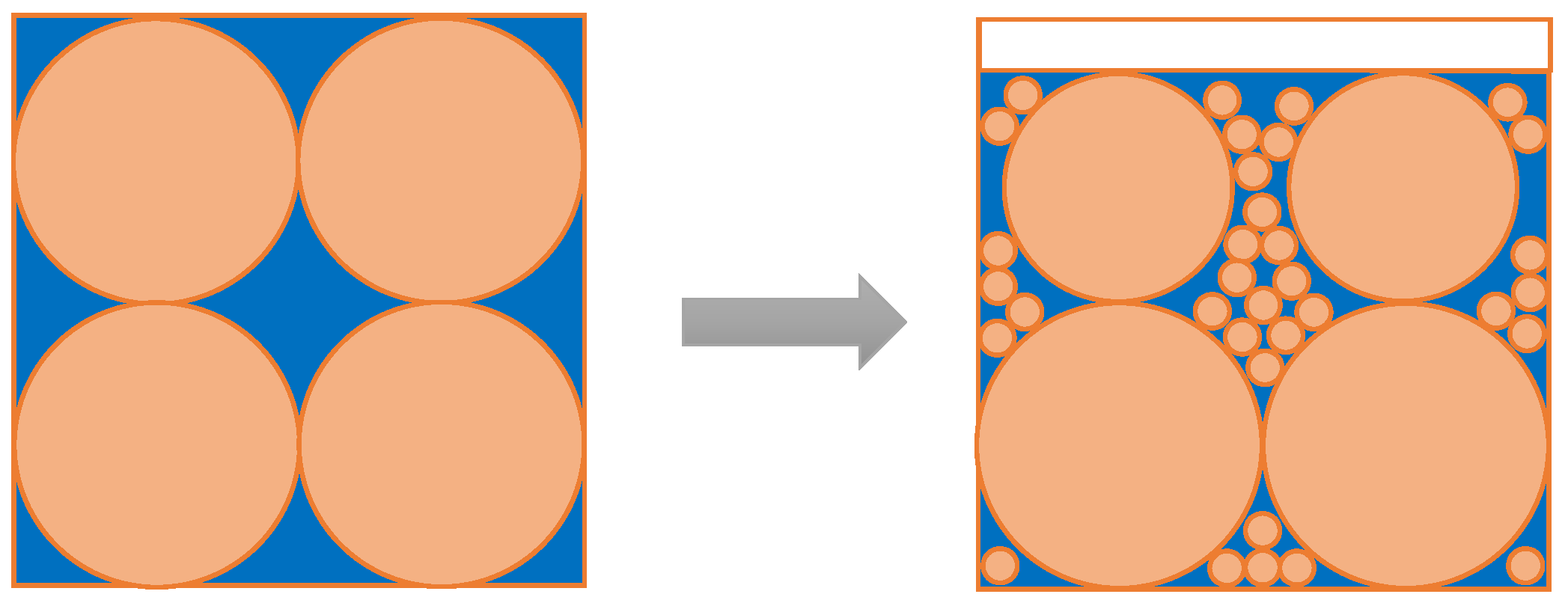
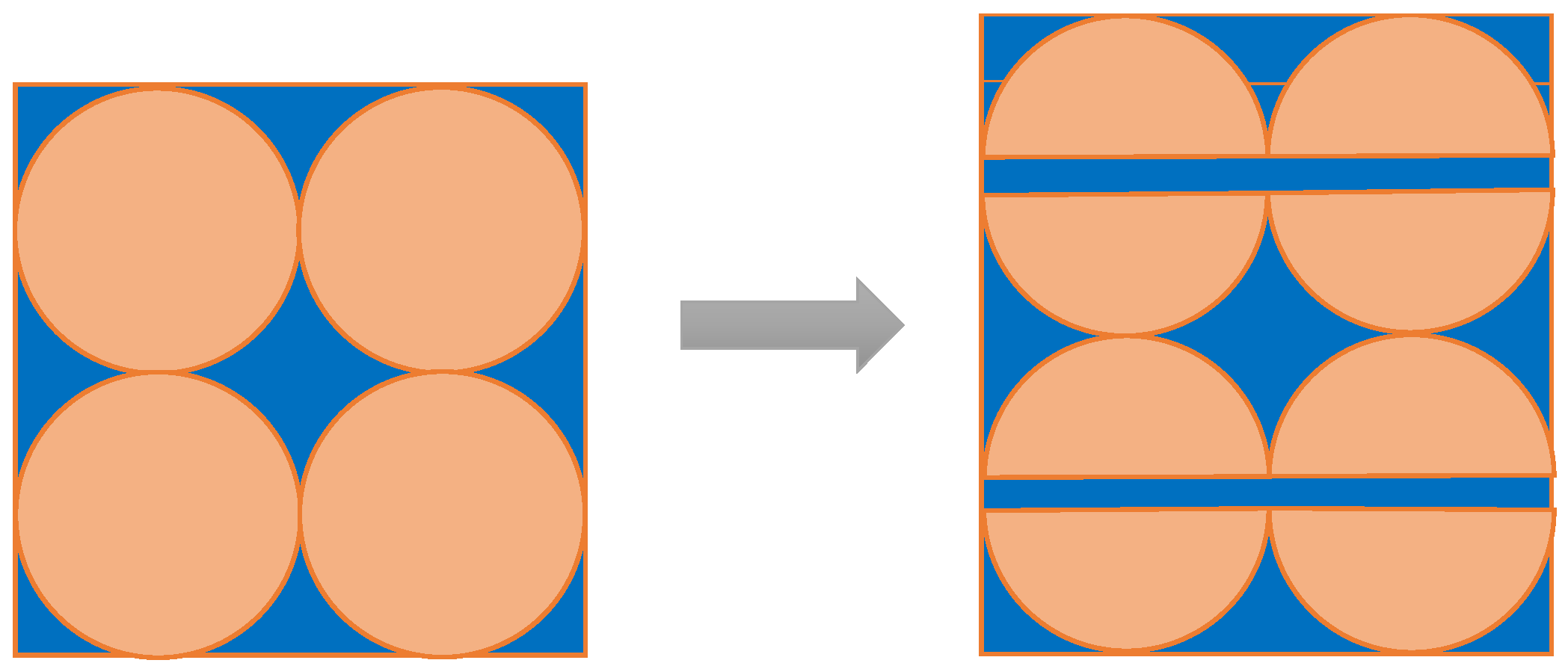
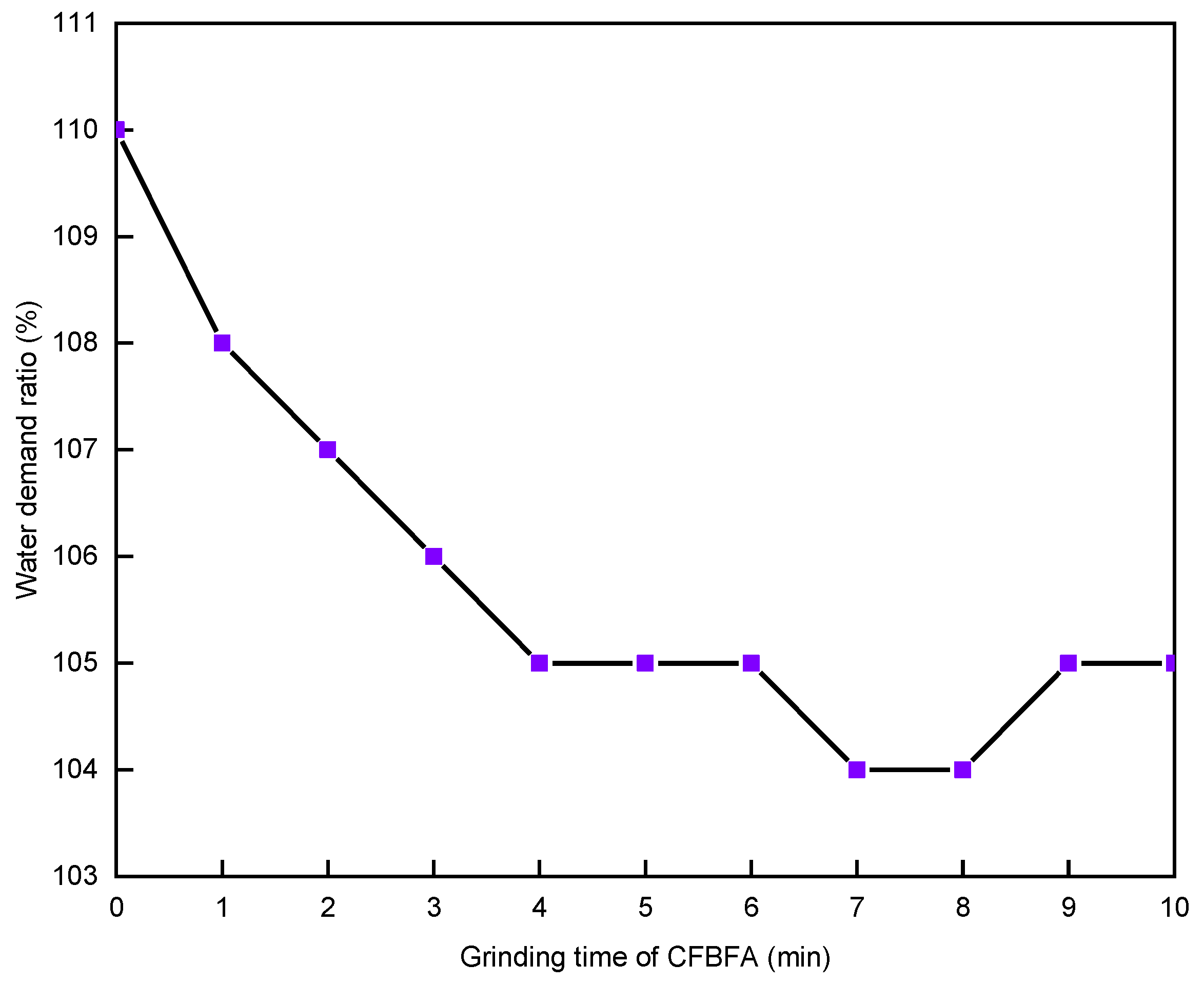
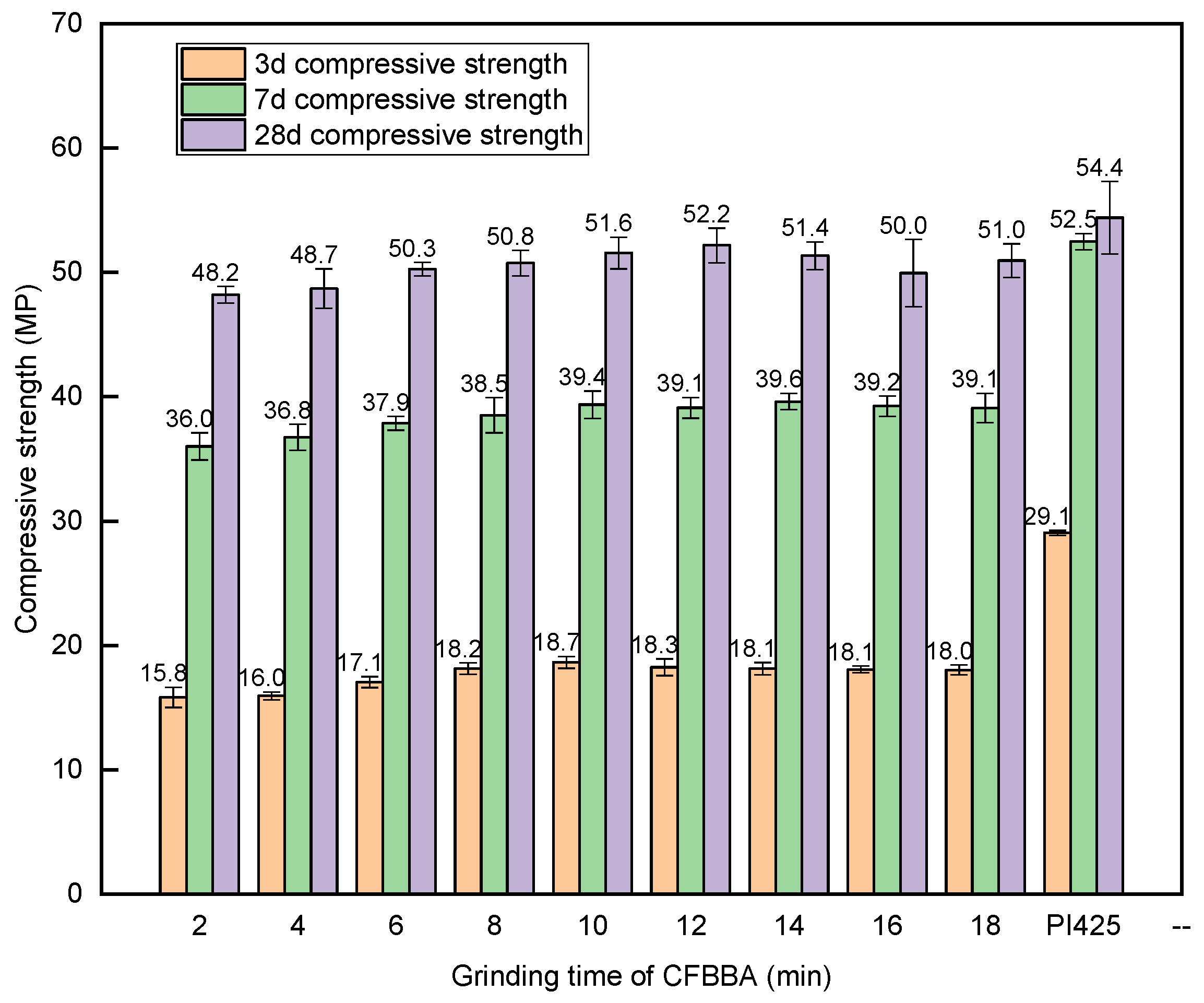


| Type of Mortar | PI42.5 Cement/g | CFBBA/g | CFBFA/g | Sand/g | Deionized Water/g |
|---|---|---|---|---|---|
| Contrast mortar | 250 | - | - | 750 | W1 |
| Test mortar | 175 | 52.5 | 22.5 | 750 | W2 |
| Type of Mortar | PI42.5 Cement/g | CFBBA/g | CFBFA/g | Sand/g | Deionized Water/g |
|---|---|---|---|---|---|
| Contrast mortar | 450 | - | - | 1350 | 225 |
| Test mortar | 315 | 94.5 | 40.5 | 1350 | 225 |
| Compound | SiO2 | Al2O3 | Fe2O3 | CaO | TiO2 | MgO | K2O | Na2O | SO3 | Other |
|---|---|---|---|---|---|---|---|---|---|---|
| CFBFA | 45.42 | 24.07 | 12.17 | 6.14 | 5.63 | 2.37 | 1.69 | 0.542 | 0.505 | 1.463 |
| CFBBA | 41.84 | 24.29 | 17.17 | 4.71 | 6.32 | 1.51 | 1.65 | 0.569 | 0.450 | 1.651 |
| Project | Second-Class Pulverized Coal Ash Standard | CFBFA | CFBBA |
|---|---|---|---|
| Fineness | ≤30.0 | 15.8 | 100 |
| Water-demand ratio/% | ≤105 | 110 | - |
| LOI/% | ≤8.0 | 2.56 | 1.17 |
| Moisture content/% | ≤1.0 | 0.30 | 0.31 |
| SO3 mass fractions/% | ≤3.0 | 0.505 | 0.450 |
| free CaO mass fractions/% | ≤1.0 | 0.22 | 0.41 |
| SiO2, Al2O3, and Fe2O3 total mass Fractions/% | ≥70.0 | 81.66 | 83.30 |
| Density/(g/cm3) | ≤2.6 | 2.44 | 2.59 |
| Activity index/% | ≥70.0 | - | - |
| Sample | d(0.1)/μm | d(0.5)/μm | d(0.9)/μm | Sample | d(0.1)/μm | d(0.5)/μm | d(0.9)/μm |
|---|---|---|---|---|---|---|---|
| CFBBA1 | 14.992 | 226.655 | 615.847 | CFBBA9 | 1.268 | 9.194 | 35.649 |
| CFBBA2 | 6.612 | 140.303 | 615.358 | CFBBA10 | 1.207 | 8.42 | 33.960 |
| CFBBA3 | 3.865 | 62.734 | 513.686 | CFBBA12 | 1.058 | 6.914 | 28.272 |
| CFBBA4 | 2.534 | 30.974 | 254.954 | CFBBA14 | 0.986 | 6.084 | 25.524 |
| CFBBA5 | 2.205 | 24.383 | 240.411 | CFBBA16 | 0.913 | 5.26 | 21.982 |
| CFBBA6 | 1.710 | 14.972 | 58.471 | CFBBA18 | 0.878 | 4.92 | 23.416 |
| CFBBA7 | 1.498 | 11.967 | 45.674 | CFBBA20 | 0.878 | 5.687 | 28.919 |
| CFBBA8 | 1.368 | 10.413 | 40.727 |
Publisher’s Note: MDPI stays neutral with regard to jurisdictional claims in published maps and institutional affiliations. |
© 2022 by the authors. Licensee MDPI, Basel, Switzerland. This article is an open access article distributed under the terms and conditions of the Creative Commons Attribution (CC BY) license (https://creativecommons.org/licenses/by/4.0/).
Share and Cite
Du, X.; Huang, Z.; Ding, Y.; Xu, W.; Zhang, M.; Wei, L.; Yang, H. Feasibility Study of Grinding Circulating Fluidized Bed Ash as Cement Admixture. Materials 2022, 15, 5610. https://doi.org/10.3390/ma15165610
Du X, Huang Z, Ding Y, Xu W, Zhang M, Wei L, Yang H. Feasibility Study of Grinding Circulating Fluidized Bed Ash as Cement Admixture. Materials. 2022; 15(16):5610. https://doi.org/10.3390/ma15165610
Chicago/Turabian StyleDu, Xingquan, Zhong Huang, Yi Ding, Wei Xu, Man Zhang, Lubin Wei, and Hairui Yang. 2022. "Feasibility Study of Grinding Circulating Fluidized Bed Ash as Cement Admixture" Materials 15, no. 16: 5610. https://doi.org/10.3390/ma15165610
APA StyleDu, X., Huang, Z., Ding, Y., Xu, W., Zhang, M., Wei, L., & Yang, H. (2022). Feasibility Study of Grinding Circulating Fluidized Bed Ash as Cement Admixture. Materials, 15(16), 5610. https://doi.org/10.3390/ma15165610








